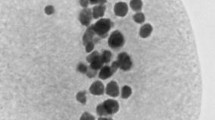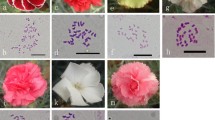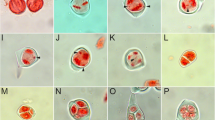Summary
Cytological analyses in series of crosses between 7 sexual pistillate and 8 apomictic staminate parents of speciesPanicum maximum (Gramineae) are reported. Although these 15 progenitors were tetraploid (2n = 32), 2 dihaploids (2n = 16), 45 hexaploids (2n = 48) and 5 octoploids (2n = 64) were observed among 333 progeny plants. The role of unreduced gametes as the originators of polyploidy is discussed in relation to the so-called ‘elements of apomixis’. The 2 dihaploids appeared to be sexual while the hexaploids and octoploids were all apomictic. At the tetraploid level sexual and apomictic hybrids segregated in a ratio close to 1∶1. These results were then compared to those already obtained from studies on other tropical grasses and indicate a simple genetic determinism for gametophytic apomixis.
Similar content being viewed by others
Literature
Bashaw, E.C. (1975): Problems and possibilities of apomixis in the improvement of tropical forage grasses. In: Tropical forage in livestock production systems. ASA Special Publ.24, 23–30
Burton, G.W.; Forbes, I. (1960): The genetics and manipulation of obligate apomixis in common Bahiagrass (Paspalum notatum Flügge). Proc. VIIIth Intern. Grassl. Congr. pp. 66–71
Combes, D.; Pernes, J. (1970): Variations dans les nombres chromosomiques duPanicum maximum Jacq. en relation avec le mode de reproduction. C.R. Acad. Sci. (Paris) sér.D 270, 782–785
Gröber, K.; Matzk, F.; Zacharias, M. (1974): Untersuchungen zur Entwicklung der apomiktischen Fortpflanzenzungsweise bei Futtergräsern. I. Art and Gattungskreuzungen. KulturpflanzeXXII, 159–180
Gustafsson, Å. (1946): Apomixis in higher plants. 1: the mechanism of apomixis. Lunds Univ. Arsskr.,42, 1–68
Hanna, W.W.; Powell, J.B.; Millot, J.C.; Burton, G.W. (1973): Cytology of obligate sexual plants inPanicum maximum Jacq. and their use in controlled hybrids. Crop Sci.13, 695–697
Harlan, J.R.; Brooks, M.H.; Borgaonkar, D.S.; De Wet, J.M.J. (1964): Nature and inheritance of apomixis inBothriochloa andDichanthium. Bot. Gaz.125, 41–46
Harlan, J.R.; De Wet, J.M.J. (1975): On O. Winge and a prayer: the origins of polyploidy. Bot. Rev.41, 361–390
Herr, J.M. (1971): A new clearing squash technique for the study of ovule development in angiosperms. Amer. J. Both.58, 785–790
Mendiburu, A.O.; Peloquin, S.J. (1976): Sexual polyploidization and depolyploidization: some terminology and definitions. Theor. Appl. Genet.48, 137–143
Nogler, G.A. (1978, in press): Zur Zytogenetik des Apomixis beiRanunculus auricomus.
Pernes, J.; Combes, D.; Rene-Chaume, R.; Savidan, Y. (1975a): Biologie des populations naturelles duPanicum maximum Jacq. Cah. ORSTOM, sér. Biol,X (2), 77–89
Pernes, J.; Savidan, Y.; Rene-Chaume, R. (1975b):Panicum: structures génétiques du complexe des ‘Maximae’ et organisation de ses populations naturelles en relation avec la spéciation. Boissiera (Genève)24, 383–402
Pernes, J.; Rene-Chaume, R.; Rene, J.; Savidan, Y. (1975c): Schéma d'amélioration génétique des complexes agamiques du typePanicum. Cah. ORSTOM, sér. Biol.,X (2), 67–75
Petrov, D.F.; Belousova, N.I.; Fokina, E.S. (1978): The inheritance pattern of apomictic elements in interspecific hybrids between maize andTripsacum. Proc. XIVth Intern. Congr. GeneticsII, 184. (Abstr.)
Read, J.C.; Bashaw, E.C. (1969): Cytotaxonomic relationship and the role of apomixis in speciation in Buffelgrass and Birdwoodgrass. Crop. Sci.9, 805–806
Savidan, Y. (1975): Hérédité de l'apomixie. Contribution à l'étude de l'hérédité de l'apomixie surPanicum maximum Jacq. (analyse des sacs embryonnaires). Cah. ORSTOM, sér. Biol.X (2), 91–95
Savidan, Y. (1978): L'apomixie gamétophytique chez les Graminées et son utilisation en Amélioration des Plantes. Ann. Amélior. Plantes28 (1), 1–9
Savidan, Y. (1980, in press): Facultative apomixis as a tool for the improvement of Guinea grass (Panicum maximum Jacq.)
Smith, R.L. (1972): Sexual reproduction inPanicum maximum. Crop Sci.12, 624–627
Stebbins, G.L. (1950): Variation and Evolution in Plants. New York: Columbia Univ. Press
Taliaferro, C.M.; Bashaw, E.C. (1966): Inheritance and control of obligate apomixis in breeding Buffelgrass,Pennisetum ciliare. Crop. Sci.6, 473–476
Voigt, P.W.; Bashaw, E.C. (1972): Apomixis and sexuality inEragrostis curvula. Crop. Sci.12, 843–847
Warmke, H.E. (1954): Apomixis inPanicum maximum. Amer. J. Bot.41, 5–11
Author information
Authors and Affiliations
Additional information
Communicated by Å. Gustafsson
Rights and permissions
About this article
Cite this article
Savidan, Y. Chromosomal and embryological analyses in sexual x apomictic hybrids ofPanicum maximum Jacq.. Theoret. Appl. Genetics 58, 153–156 (1980). https://doi.org/10.1007/BF00279706
Received:
Accepted:
Issue Date:
DOI: https://doi.org/10.1007/BF00279706




